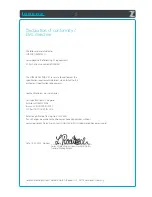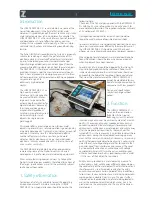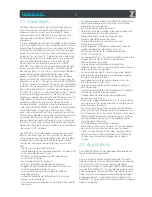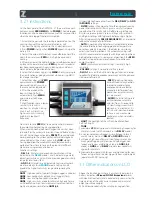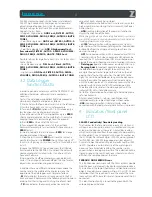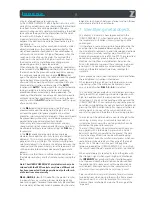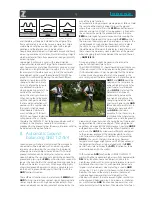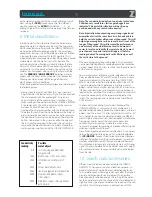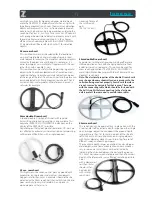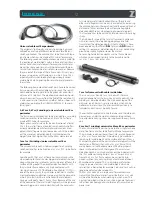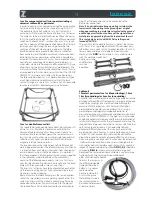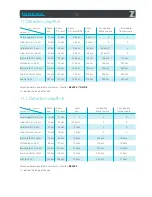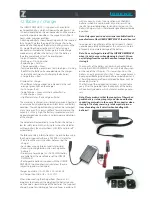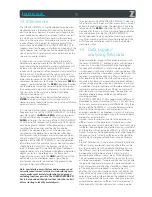
O R E N Z
OPERATING MANUAL
Introduction
The LORENZ DEEPMAX Z1 series detectors are some of the
newest developments in the field of Pulse GBS metal
detectors. It is probably one of the most sensitive and stable
metal detecting devices of its kind presently available. The
LORENZ DEEPMAX Z1 is the result of many years of research
and development. A lot of efforts have been put into
making this new product and especially in the new impro-
ved metal classifications and automatic ground balancing
facilities.
The Pulse GBS (Pulse Ground Balancing System) is especially
suitable for searching at depth. The performance of this
electronic device is almost unaffected by salt water, most
types of mineralized grounds or temperature changes.
Specially designed electronics cancel out signals from the
ground while offering stable signals from the metal objects.
The DEEPMAX Z1 is therefore a reliable tool to locate at
great depths even under the worst environmental condi-
tions. A new improved circuit design suppresses interferen-
ce from power lines and a power pulse technique produces
very accurate signals to
obtain very high detection
depths.
The LORENZ DEEPMAX Z1 is a
high quality specialist
Detector and it is designed to
be used with both, small or
large coils. Large coils offer
extreme depth capabilities for
big metal objects because of
the strong and deep going
magnetic field produced.
Small coils are preferably used
while searching for small
objects like single coins or
gold nuggets.
This model offers a great range on non-ferrous metal
objects in general. A very simple operation is guaranteed by
a specially developed LC Display and a minimum amount of
controls. At the same time this detector model offers a
number of features which are new for a pulse metal
detector. Quality electronics and very special designed
electronic - circuitry produce benefits in terms of ease of
use as well as sensitivity.
The DEEPMAX metal detectors are often recognized as
representing some of the highest quality and newest
developments in professional metal detecting equipment.
We as a manufacturing company always try to keep the
highest standard on our products, therefore alternations of
the design, specifications as well as the availability subject
to change without notice.
1. Safety information
For reasons of safety it is advisable to read this operating
Introduction manual first before turning the LORENZ
DEEPMAX Z1 on. Special attention should be paid to the
following notes.
Check out, if the fast charger supplied with the DEEPMAX Z1
fits with the AC mains of your country. See chapter 12 for
more detailed information. The supplied recharger will work
at AC voltages of 90-264 VAC.
Damaged connecting cables or search coils should no
longer be used, because of possible electrical shock.
To avoid short circuits, wrong polarity or electrical shock, only
spare parts and accessories offered by the manufacturer of
the LORENZ DEEPMAX Z1 should be used. When head-
phones are in use please reduce volume to protect your ears.
When digging for metal objects war material could also be
found. Precautions should be taken in advance especially
when big objects have been located.
Special kinds of mines could be triggered by the strong DC
magnetic field produced by the search coil. Persons with
implanted pacemaker or other sensitive device should not
approach to the field of the search coil. Please understand
that we as the manufacturer of the LORENZ DEEPMAX Z1
cannot be made liable for any
kind of damage caused by or in
conjunction with our products.
Design and specifications
subject to change without
notice!
2. Function
The LORENZ DEEPMAX Z1 is
based on the non- motion;
Pulse GBS (Pulse Ground
Balancing System). Short and
intensive magnetic pulses are emitted by means of a search
coil first. Those magnetic pulses produce eddy currents in
conducting materials like metal objects for example. Said
eddy currents will be kept in a metal object and will die away
after the magnetic pulse emitted by the search coil has
turned off. This is the reason why it is possible to detect those
eddy currents during the time delayed receiving phase by
means of the same search coil which now acts as a receiving
coil. A rather complicated electronic circuitry is necessary to
detect those tiny voltage changes and has to separate that
particular signal from interference also received. The signal
has to be amplified to drive an audio stage with voltage
controlled oscillator (VCO), which emits an audible signal
either by headphones or built-in loudspeaker when a metal
is in the near of the field of the search coil.
Eddy currents produced in a metal object by means of a
pulsed primary field, will die away differently depending on
the conductivity of the metal object. The classification circuit
therefore gives a visual time delay reading for the eddy
currents received over a certain period of time. In addition a
ferrous/ non- ferrous indication for a metal being detected is
working when a double D coil is in use. This gives further
information on the probable kind of metal being located as
well as the audio sound emitted, which makes it easy to
predetermine the exact place and the size of the buried
metal object.
3. Z1 instructions
On the front panel of the DEEPMAX Z1 there are three push
buttons namely
ZERO
,
MENU
, and
POWER
. The data logger
function can also be operated by means of the same controls
when the data logger function is turned on.
1. Assemble the coil with the telescopic pole and put on the
carrying strap with the battery and electronics unit
2. Connect the battery and coil to the Z1 electronics unit
3. Press
POWER
shortly, when
LOW BAT
appears charge the
battery first
4. To start the automatic two steps Ground Balance hold the
coil in the air and press
ZERO
until a high beep sound is
coming
5. Afterwards lower the coil to the ground without moving at
a place with no metal and press
ZERO
again until a second
low beep sound appears. Arrows pointing up- and down-
wards indicate the position of the coil.
6. Select the functions by pressing
MENU
shortly jumping to
the next function or going backwards while pressing MENU
for a longer duration
7. Select the values with
ZERO
upwards and with
POWER
downwards quickly pressing
the same button repeatedly.
8. After three seconds the
Icons will stop to flash
automatically. Press
MENU
again in order to change
functions
9. Most functions have a lower
sensitivity/ intensity in
position 1 as a higher setting
like 4, 5 or 9 will result in a
higher sensitivity/ intensity/
brightness/ loudness/
frequency…
From time to time
ZERO
has to be pushed shortly to recall
the audio threshold setting during operation.
When a search coil has been exchanged, the unit has been
turned off, or the automatic two steps Ground Balance (steps
4 and 5) has not been activated a
PRE SET
Ground balance
corresponding to the various coils and standard magnetic
soil conditions will be always active in the
GND
modes!
During operation the automatic Ground Balance can be
performed from time to time on the ground at different
places or on single magnetic stones.
Functions/ settings
•
DEL 1- 4
All metals and ground mineralization will be
indicated in this
DELAY
mode. 1 and 2 indicate large metal
objects only while 3 and 4 will also provide a good sensitivity
range for small coins/ foils.
•
GND 1-4
All metals are indicated while mineralized soils
are eliminated in this
GROUND
mode. Setting 3 and 4
provide the highest sensitivity range while ignoring the
ground.
GND1
High conductivity objects (bigger nuggets and coins)
GND2
Low conductivity objects (small nuggets, foils)
GND3
Low and high conductivity objects
GND4
High sensitivity mode for all metals but only for use
with double D coils on low/ medium mineralized soils. For
highly mineralized soils refer to
GND1,2,3
It is possible to choose either from the
DEL (DELAY)
or
GND
(GROUND)
settings.
•
FILTER
reduces the amount of interferences produced by
power lines radio transmitters, 0 gives a very fast response
speed but no filter at all and 5 will offer a low interference
but slow response speed. Use low settings with small coils
and higher settings with large coils. Before using a higher
Filter setting adjust the
FREQ (FREQUENCY)
first, in order to
reduce the amount of interference.
•
AUTO
in position 5 the detector will automatically retune
the audio threshold to changing ground or temperature
conditions quickly. In position 1 the detector very slowly
adjusts itself and in position 0 this automatic tuning is off
which is recommended especially with large coils to achieve
high detection ranges. In some cases at position 0 the
ZERO
control has to be pressed more frequently to achieve an
audio threshold.
•
SENS
sensitivity adjustment setting: 1 low and 5 high
sensitivity
•
VOLUME
settings: 0 no audio and 9 very loud
•
DLOG 1
turns on the built in data logger function in order
to collect field data to produce color maps with the optional
Hardware/Software kit
•
FREQ
Operating Frequency
can be altered to any position
in order to provide steady
audio sound when electro-
magnetic interferences from
power lines or radio transmit-
ters are present
•
AUDIO
the initial ticking rate
or threshold sound can be
adjusted from -9 no sound to
+9 slow ticking/ weak thresh-
old sound. In most cases it is
left in 0 mid- position in order
to have a very weak audio
sound even when no metal is
located.
•
LIGHT
the backlight of the LCD can be altered from
0 off to 9 bright
•
TONE
1
provides a
VCO
ticking sound with increasing frequency for
all metals (useful with frame coils in the
DELAY
modes)
2
increases volume and frequency simultaneously for all
metals (works well in all
DELAY
or
GROUND
modes)
3
will give a high sound for small non-ferrous metals like
many gold Nuggets and a low sound with bigger non-
ferrous and ferrous metal objects (only in
GND 1,2,3
mode). In
GND 4
or all
DELAY
modes a low sound will
appear for all metals.
4
provides a low sound with ferrous and high sound for non-
ferrous or large (hand sized or bigger) ferrous metal objects
(operates with DD- coils only)
3.1 Other indicators on LCD
Above the function icons there is an intensity bar graph, a
battery indicator, a
FErrous/ NON- FErrous icon
(works
with double D coil only) and a conductivity number for the
time duration of the eddy currents produced in a metal
object, possible examples:
000-035 low conductivity like small coins nuggets foils
INTENSITY / signal intensity bar graph icons
The signal strength will be indicated by the way of a large
bar graph in the middle of the LC Display and an audio
response from the speaker or headphones.
ARROW; AERIAL, USB icons
These icons will work together with the built-in data logger
function. For further information please refer to the instruc-
tions for use the LORENZ DEEPMAX Z1, six channel data
logger, Surfer and Scripter Software chapter 3.2
BATTERY icon
The battery condition will be displayed on the bar graph
with 5 bars located on the top of the display. Note: The
battery condition should be checked with a search coil
connected and after a few minutes of operation.
BATTERY alarm LOW BAT
Low battery condition will be indicated by a pulsed beep
sound every few seconds. The LORENZ DEEPMAX Z1 will
turn OFF automatically a short time after this sound appears
to avoid damage from the batteries. The pulse circuit is
automatically turned off at low battery for safety reasons.
5. Connectors
BATTERY jack
This jack is located on the side
of the control housing.
The plug of the supplied
battery pack has to be
connected with this three way
jack. The operation time of the
LORENZ DEEPMAX Z1 on a
fully charged battery pack at
normal temperature range is
approximately 7 to 14 hours
depending on the coil
connected.
HEADPHONE- jack
The supplied stereo headphones can be connected to this
jack. Headphones with coded 4 way plug should be used
from the manufacturer. The built- in loudspeaker will be
automatically turned off when headphones are connected.
Loudspeaker
The LORENZ DEEPMAX Z1 has got a built-in loud-speaker
on the front which gives an audible signal when the
search coil approaches to a metal object. The audio
frequency and volume intensity will change with the
distance between the search coil and metal for better
pinpointing. Especially with two persons operation and
large diameter coils the signal from the loudspeaker is of
great help for both persons.
GPS Module / data transfer jack
The LORENZ DEEPMAX Z1 has a built-in data logger. In
order to support the same withpositioning data a GPS
Module can be connected to this five way jack. An
optional Data Logger Hard and Software kit would be
necessary doing this. After collecting field data the same
can be transferred via the same connection to the compu-
ter with an USB data transfer cable using the same jack.
COIL jack
Search coils of different size and shape can be connected to
this jack. The search coils available for the LORENZ DEEPMAX
Z1 have got coded connectors to adapt the electronics to
the coil automatically. To connect a coil plug to the electro-
nics make sure that it is fully pushed in the jack and that the
sleeve is fastened by rotating it clockwise.
Note: Any connectors should be disconnected when
planning to store the equipment.
6. Operating procedures
Do connect the two shoulder straps to the main belt at both
sides in the front and one large strap above the battery pack
on the back. Adjust all the belts to comfortable length and
fasten the main electronics unit in front of the operator.
Connect the search coil-connector to the COIL jack on the
right hand side of the electronics unit, and fasten the plastic
sleeve of the connector by rotating it clockwise. Do connect
the battery connector to the BATTERY jack which is located
on the left side of the detector by pushing it gently. Hold
the connected search coil horizontally and far away from
metal objects about one
meter above the ground. Set
the POWER button to turn the
LORENZ DEEPMAX Z1 on. Press
again for a longer duration in
order to turn “OFF”. At switch
ON the detector runs through
a display check sequence since
all the icons com on and
indicate the retuning process
is performed by the electro-
nics at the same time. If the
BAT icon displays less than one
bar afterwards or if the
BATTERY alarm gives a beep
sound every few seconds, the
detector should be turned off again and the battery should
immediately be recharged with the supplied charger. The
battery condition is displayed with five bars on the top of
the Display continuously during operation.
Afterwards the Detector will automatically turn to the
positions which were selected the last time the detector
was in use. While pushing the
ZERO
,
MENU
,
POWER
push
buttons different settings will be selected and will be
displayed on the bottom of the LC Display at the same time.
See chapter 3 for details.
During operation no metal buckles or shoes containing
metal parts should be worn. The same with keys, coins, rings
and watches. Every metal carried by the operator can cause
false signals, especially when they are located near the field
of the search coil. Therefore the electronics control box has
to be carried far away from the search coil, this is especially
important while searching with the large frame mounted
coils but also with the smaller coils. Never use any metal
screws when building frames for the cable coils.
The loudspeaker will give a ticking or threshold sound after
having retuned the detector correctly with the
ZERO
control.
The sound can be individually tuned from silent to a low
frequency threshold tone with the
AUDIO
settings. This
pre-set audio tone will be recalled every time the
ZERO
control is pushed. This has to be done during the first
and therefore will only be indicated at the edges of the
frame coils and only when they are very close to it. Large
metal objects will give an extensive signal with a longer
duration, and therefore can easily be identified.
Deeply buried metal objects will generate a weak and slowly
increasing audio sound and intensity meter reading. Objects
which are close to the surface generate a strong and rapidly
increasing signal.
Large objects will cause a signal with a long duration
especially when located with large frame mounted cable
coils. For example a metal box 20cmx20cm can give a signal
of up to 6 m in length when passing with a (2 m x 2 m) coil
for example. It is therefore necessary to find the center of a
buried object by the way of the audio and INTENSITY bar
graph. This is achieved by moving the coil from different
directions slowly towards the
strongest indication. In many
cases it is of great help to use
an additional smaller coil
when pinpointing a metal. The
centre of the search coil is
always the most sensitive part.
When having found the place
with the strongest indication
the time delay indication will
come on with a number when
the signal is strong enough.
When double D coils are in
use an additional FE ferrous /
NON-FE non-ferrous indication
will appear on the LC Display.
Therefore the DEEPMAX Z1 has to be ground balanced first
as shown in the chapter 3 to avoid false indications
produced by the ground. Larger ferrous metal pieces will also
be indicated as being non-ferrous.
8. Automatic Ground
balancing GND 1/2/3/4
Ground signals which are mainly derived from magnetic
iron oxides will be indicated with an increasing audio
response when lowering the search coil to the ground
although no metal is below the search coil. This kind of
ground indication can be simply eliminated by simulta-
neously holding the search coil at constant height over the
ground and pressing the
ZERO
push button for a second. As
long as the coil is hold at the same height during searching
there will be no loss in sensitivity. When expecting highly
mineralized ground however it is always advisable to turn
on the built- in ground balancing System (GBS) with the
GND
function turned on.
These different functions can be selected with
MENU
and
GND
flashing, in order to cancel out signals from magnetic
soils or single stones with high iron oxide contents. Even
some iron objects can be discriminated/ eliminated by the
way of the same functions.
For automatic tuning purposes please go on as follows. Hold
the search coil horizontally about 1m over the ground
where there is no metal. Press the
ZERO
control for several
seconds and wait until the first tuning process is finished in
the air. Lower the coil to the ground and press the same
ZERO
control again for several seconds while keeping the
coil close to the ground. When pressing the
ZERO
control
the arrow on the display points up and down as long as the
tuning proceeds. High and low beep sounds will indicate
the same. During that time no movements of the coil
should be done. Afterwards the detector is ready for use and
there should be no or only weak indications of the ground
when changing the distance between the coil and the soil
in
GND1/2/3/4
.
During operation it might be necessary to retune the
ground settings from time to time.
The LORENZ DEEPMAX Z1 should now be almost silent even
if the coil is raised in the air or lowered to the ground again.
If still indications occur it may be possible that the Detector
has been tuned to a piece of metal in the ground. In this
case simply repeat the same procedure at a metal free place.
GND 1
and
GND 2
could be
selected at the same time to
achieve highest sensitivity for
most types of metal objects
when
GND 3
is selected. The
Detector will distinguish
automatically between the
two signals and will use the
stronger signal of the two. In
most cases however the
GND
2
function will be sufficient. In
the case of a connected DD
coil
GND 4
will also be
available. It is not necessary to
run through the whole tuning
process every time the ground
properties changes but when changing the coil the ground
compensation has to be tuned again. If changing ground
conditions are expected the 35cm double D-coil and
GND 2
or
3
positions will be the best choice. When Double D coils
are in use, the
GND 4
function works differently compared
to the previous explained. The detection depth to many
non- ferrous metal objects will significantly increase when
GND 4
is in use with that coil. In some cases however
temperature changes might cause a drift of the audio and
the detector therefore has to be retuned with the
ZERO
control from time to time or the
AUTO
function has to be
selected to cope with this matter.
With turned on
GND
function the LORENZ DEEPMAX Z1
works with either reduced or higher sensitivity compared to
DEL
Delay functions. Some iron objects and very few
non-ferrous metals with a similar signal response as iron will
be indicated less sensitive. It is even possible to eliminate
large or small iron objects when selecting a special
GND
setting like 1, 2 or 3. Signals will still occur when the distance
between the coil and the metal is too small because of
signal overload. However most metal objects will be
detected with almost the same or even higher sensitivity as
without ground balancing circuit. An increase in interferen-
ces with turned on
GND
function due to power lines and
radio transmitters will be realized. The amount of interferen-
very high sensitivity for bigger and deeper metal objects
make the DEEPMAX Z1 especially useful when using it with
large frame mounted search coils. The maximum detection
depths achievable with a 1m x 1m frame mounted search
coil are very high and can be increased when enlarging the
search coil to 1,5m x 1,5m, 2m x 2m or 3m x 3m. Of course it
will no longer be possible to detect single coins or nails with
those large frame mounted search coils. In this chapter
different search coils available with the LORENZ DEEPMAX
Z1 are described. (Please refer to chapter 11 for detection
depths)
26 cm search coil
This search coil was mainly developed for the location of
very small metal objects like small nuggets or coin sized
metal objects for example. The maximum detection depth is
limited by the object size and the coil. In some cases it is
easier to pinpoint very small metal fragments with this coil
rather than with a double D- coil.
This search coil can be useful while pinpointing large metal
objects which have been located with a frame mounted
search coil before. Deeply buried metal objects can be out
of the range of the small 26 cm search coil and therefore can
only be detected with frame mounted search coils. The 26
cm search coil is waterproof and therefore can be used in
saltwater for example.
26cm double D search coil
A special double D version of this coil with separate
transmitting and receiving windings is also available. This
coil makes FERROUS / NON-FERROUS indications on the
display of the DEEPMAX Z1 possible.
Depending on the type of ground sometimes DD- coils are
less affected by extremely mineralized soils but pinpointing
will be more difficult than with a single loop coil.
35 cm - search coil
This highly sensitive search coil has got very good depth
capabilities on single coins and medium sized objects.
Nuggets smaller than 5mm in diameter should rather be
detected with a 26cm search coil than with this coil due to
poor sensitivity to very small metal bits and pieces. A
elescopic pole with armrest is
necessary for any of
the small search
coils
(26 / 35 / 45 cm).
35cm double D search coil
Separate transmitting and receiving windings offer more
stable operation on soils with changing contents of iron
oxides (minerals) in some cases. This coil can be used for
most search applications. The FERROUS / NON-FERROUS
metal identification does work with these 26cm and 35cm
double D search coils.
Note: The electrical properties of the double D search coils
may change when mechanical tension is produced in the
coil when being used not properly. Search coils therefore
are not covered by warranty for that reason. The same
with the connecting cable which should be fastened with
the belt strap first before connecting to the electronics
unit to protect the same and to avoid broken cables.
45cm search coil
This search coil can be operated by a single person with the
S-rod-handle. It offers extreme depth ranges on either single
coins or bigger objects buried deep in the ground. Depth
ranges of more than 1 m for a metal object of the size of a
soft drink can (0,33 l) or up to 50cm on a single gold coin
with 25mm diameter make this coil interesting for a lot of
different search and locating purposes.
Those extreme depth ranges on medium sized and bigger
metal objects make frame mounted search coils unneces-
sary in some cases. Small items can be eliminated by
increasing the distance between the coil and the ground.
This 45 cm coil covers much more ground than a 26cm coil
does and therefore makes very effective searching possible.
Coins
with a diameter of
less than 15mm
should rather
be detected
with smaller
search coils.
2.1 Advantages
The Pulse GBS principle has got the advantage of using
large diameter coils and high transmitting power. This is
especially necessary when searching at depth. Frame
mounted cable coils of different size and shape can be
connected to the LORENZ DEEPMAX Z1 without any
adjustments.
A special adaptation circuit has been added to the Detector
to suit with different coil systems automatically. This ensures
extreme depth capabilities with any coil connected. When
enlarging the search coil diameter the sensitivity to bigger
objects will also rise. At the same time smaller objects will
be located less sensitive. This is particularly desirable when
locating large objects while ignoring small bits. Large coils
offer very high detection ranges. Even in difficult soils
where magnetic iron oxides are present the LORENZ
DEEPMAX Z1 will offer extreme depth capabilities for both
ferrous and non-ferrous metal objects when the Ground
Balancing System is in use. Other systems often suffer from
ground effects which reduce the depth range in the
ground. The LORENZ DEEPMAX Z1 will be able to locate
objects at almost the same depths either in most types of
ground or »in air tests«. The high sensitivity of the DEEPMAX
Z1 to non- ferrous metal objects like gold, silver and copper
together with the new metal analysis make this detector an
outstanding device for many different locating purposes.
The DEEPMAX Z1 gives a visual indication on the LC Display
for every metal being located. This time delay reading
producing a number between 000 and 099 helps to classify
metal objects. The metal classification circuitry is only in
some cases affected by the size of a metal object and
therefore identifies small coins as well as large pieces of
metal. The LORENZ DEEPMAX Z1 also offers a sophisticated
and refined ferrous / non- ferrous metal analysis which
works more stable on difficult soils in conjunction with the
26cm or 35cm double D search coil. The Detector also emits
an audible sound by way of either a speaker or head-
phones. Detection depths achieved (in air tests) are almost
the same in many types of soils and therefore considerably
higher than those possible with standard pulse induction or
sine wave VLF - TR Detectors.
The DEEPMAX Z1 was developed to provide a number of
features including high sensitivity and stability together
with easy operation. The amount of controls was therefore
reduced and a calibration of the detector to our factory
settings was also made to guarantee best results in the
field:
• Highly sensitive to all kinds of metal
• Stable operation on mineralized ground or salt water with
Pulse Ground Balancing System
• Reliable / simple operation with few controls and
customized LC Display
• Exact pinpointing with large coils
• Very easy and effective detection of large areas
• Rugged, refined mechanical construction with water
and dust protected electronics unit
• A variety of search coils are available for different
detection purposes
• Automatic adaptation of different coil sizes and coil
designs to the electronics
• Small unwanted metal objects can either be identified or
eliminated
• Fast audio response speed with different audio settings
• Logarithmic audio response and intensity bar graph
reading for easy pinpointing
• Battery check with audio alarm tone
• Calibrated static (non-motion) metal classification with
visual conductivity/ time delay reading
• Improved ferrous/ non-ferrous identification
• Precisely adjustable audio-threshold
• Stable static response (acoustical and visual)
• Waterproof search coils
• Interchangeable rechargeable NIMH Battery pack for
worldwide operation, declared as dry cells!
• Fast charge electronics for worldwide operation
90-265V AC/50-60Hz
• Car charger for 10-30V DC supplies available as accessory
• Frequency and Filter function for low frequency
EMI interference elimination
• Automatic ground calibration retuning facility
• Different Delay and Sensitivity settings to eliminate small
objects or for easy pinpointing
• Extreme detection depths for very large metal objects
• Specialized on gold and improved detection range on
low conducting metal pieces
• Low frequency interference elimination circuitry for
less interference in urban areas.
• High dynamic range for extreme ground signals and
easy pinpointing
• Optimal performance for the detection of small objects
like coins or other non-ferrous objects
• Single or dual, induction balanced or differential
coil designs can be used
• Multi sensor trigger detection (MST) with several search
coils working at the same time without interfering each
other. Please ask for details.
• Easy to use data logger function works with additional
Hard- and Software kit to generate six 2D image and six
3D surface maps from the scans being taken. Each map is
different depending on the electronic analysis method
and therefore can be the key to the probable kind of
metal buried in the ground.
• GPS based Meter and Compass Heading
information, makes it easy to work with the data logger.
• New search system circuitry with all new functions.
• Signal strength bar graph, time delay reading, ferrous/
non-ferrous icons, battery condition and all the mode
settings are displayed simultaneously on a large LC
Display.
2.2 Applications
The LORENZ DEEPMA Z1 was developed for professional
search and locating applications.
A variety of search coils can be connected to this metal
detector. Large areas can be detected effectively especially
with frame coils. Saltwater, most types of ground or
temperature changes will only slightly affect the detection
range of the DEEPMAX Z1. It is possible to eliminate some
unwanted objects like nails and foils or to identify them as
being small unwanted objects while searching for bigger
and deeper objects. In conjunction with small coils the
DEEPMAX Z1 is a great tool when searching for small objects
deep in the ground.
minutes of operation due to warming up.
As the LORENZ DEEPMAX Z1 offers highest sensitivity with
correctly tuned electronics, one should check the threshold
tone from time to time during operation. Although a
constant ticking sound is not always achievable, a threshold
tone will give the operator the information that the detec-
tor works with its highest sensitivity.
Especially for metal classification and ground balancing
purposes the electronics need to be tuned for best results
(see chapter 3).
The detector is now ready for use and will indicate a metal
object immediately with an audio sound emitted by the
way of loudspeaker or headphones. The audio frequency
will rapidly rise and attains its highest frequency when the
search coil is directly over the metal. The centre of the
search coil is the part with the highest sensitivity. Even in
the direct near of the metal frequency changes make
pinpointing possible in some tone modes.
When changing the search coil the electronics need always
to be retuned via the
ZERO
control shortly. When lowering
the search coil to the ground an audio sound may appear,
this can be canceled out by pressing the
ZERO
control
again. The distance between the search coil and the ground
has to be kept at a constant height when searching
afterwards. When working with small search coils of up to
45cm diameter it is also possible to select the
AUTO
function with
AUTO
1 for slow and 5 for very fast automatic
tuning in order to retune the electronics to changing
ground conditions automatically during operation. The
search coil therefore has to be moved at constant speed to
achieve a signal from metal objects. When resting the coil
over the metal the
AUTO
function will cancel out the signal
after a certain time.
In the
DEL
modes large diameter coils like the frame
mounted cable coils should be hold at heights of (10 to 60
cm) over the ground to ignore magnetic mineralized
ground or small unwanted metal objects. Those coils should
be moved slowly without any up and down movements,
parallel to the ground and at constant height.
When many small unwanted bits and pieces and very
strong wanted signals are expected at the same time it may
be advisable to select a lower delay setting like
DEL
3 or 2
for example.
In the
DEL
2 mode and especially while using large
diameter frame coils the sensitivity to very small objects
decreases. This is in many cases desirable, although the
general sensitivity will be less. The simplest way to ignore
small metal objects is to increase the distance between the
search coil and the ground. Simply raise the loop and it will
still be possible to locate those deeper and bigger metal
objects.
Be always sure that there is a sufficient distance between
the detector or battery and the frame coil when raising the
loop.
Note: The LORENZ DEEPMAX Z1 metal detector has to be
retuned with the ZERO control every time a different coil
has been connected. During operation only a few thresh-
old corrections are necessary.
DEL 4, GND 2, 3, 4
with DD coil offers the greatest sensitivi-
ty especially for very small non-ferrous metal objects like
coins and nuggets. To record the conductivity (derived from
the time delay of the eddy currents produced by the metal
objects) or to distinguish between a ferrous and non-ferrous
metal please refer to the next chapter.
7. Identifying metal objects
This chapter is a summary how to proceed with the
LORENZ DEEPMAX Z1, when locating metal, while using
the two metal classifications, intensity reading and the
audio signal.
It is therefore in some cases possible to predetermine the
exact position, the probable detection depth as well as
the kind of metal located. A specially developed electronic
circuit makes time delay readings possible which are
directly displayed on a scale of 000 to 099. Those so called
conductivity readings are only known from VLF TR-
Machines but not from metal detectors based on the
Pulse-GBS principle. In general these readings are based
on object’s size, conductivity and permeability of the
metal and therefore named time delay readings for
simplicity.
Please proceed as described in chapter 3 and 4 and follow
these additional instructions listed below.
When lowering the search coil to the ground an increa-
sing ticking-rate of the audio can be audible in some
cases, especially when
DEL 1, 2, 3, 4
is selected.
This can either be generated by a metal object or minera-
lized ground. When expecting mineralized grounds with
high iron oxide content the search coil can simply be
raised again, (10 to 50 cm) depending on the coil and the
LORENZ DEEPMAX Z1 can simply be tuned to the ground
conditions while holding the coil at a constant height and
pressing the ZERO button shortly. Pay special attention to
metal objects in the near of the search coil which may
cause false signals and therefore a false retuning process.
The search coil should be held at a constant height while
searching. In many cases it is advisable to search in a
systematically manner with a certain grid which can be
marked on the ground for example.
The small (26cm; 35cm; 45cm) diameter search coils can
be supplied with a telescopic S- pole which is held at
constant height and in parallel to the ground. The coils
have to be moved from side to side with overlapping
tracks to detect even the smallest metal pieces which can
sometimes only be detected in the centre of the search
coil as this is the most sensitive part. Although the
response speed of the LORENZ DEEPMAX Z1 is very high,
the search speed should not exceed 2 meters per second.
When a metal object is located try to find the place with
the strongest signal which means highest indication on
the
INTENSITY
bar graph and highest audio frequency.
Size, shape and depth information can be derived from
the audio sound in some cases with some experience.
Small objects like single coins will be indicated with a
short and intensive signal when a small coil is used.
Coins and nails and very small pieces of metal will cause
two indications when passing them with a frame moun-
ted search coil (1 m x 1m) for example. This is mainly
because those small objects are out of the range of the
large coils
ces could only be reduced by the way of changing search
coils, setting the
FREQ
Frequency control to a different
position, reducing the
AUDIO
threshold to -1, -2… or
adding a higher Filter setting with some expense of respon-
se speed.
9. Metal classification
In order to get further information from the buried metal
object the metal classification can be used. The two metal
classification features offered with the LORENZ DEEPMAX Z1
are based on different working principles. The time delay/-
conductivity reading is static therefore no motion of the coil
is required to make a reading 000 to 099 possible. This is
especially of great advantage when identifying deeply buried
metal objects with the highest sensitivity possible. The
calibrated metal classification will directly display the time
delay with all coils connected. This conductivity reading is
very precise. It will be stored as long as the coil is over the
metal and will disappear when passing the metal with the
coil. The
FERROUS / NON-FERROUS
indication will only
appear with the 26 cm or 35cm double D coil connected.
Weak signals which are out of the range of the metal
classifications can’t be identified.
When having located a metal object proceed as described in
the following steps:
• Slowly move the search coil from the side at constant
height towards the located metal. Try to find the centre of
the metal object with the audio signal. As soon as a
certain intensity of the audible signal is reached a time
delay reading will be performed by the LORENZ DEEPMAX
Z1 automatically. This will be indicated with a number
between 000 and 099 on the screen.
• Compare the displayed number with the following table.
Therefore the search coil has to be held over the metal in
order to store the conductivity value. For better accuracy
the conductivity reading can be repeated. Therefore the
coil has to be raised in the air or moved to the side until
the first reading disappears. Afterwards the coil can be
lowered to the ground towards the metal until another
meter reading is performed by the LORENZ DEEPMAX Z1.
Note: The conductivity indication can also be locked near
000 when very small coins, foils or gold nuggets are
indicated. This metal classification will work in any
position and with any search coil connected.
Note: Especially when expecting very strong signals and
mineralized soils at the same time it is often advisable to
hold the coil at a higher distance over the ground. This will
help to ignore magnetic soils, because the coil is out of the
range of the ground. This will increase the performance
and accuracy of the classification circuit and makes it
easier to locate and identify these metal objects. In most
cases however a special circuit will suppress the false
readings derived from magnetic soils effectively, even if
the coil is close to the ground.
When expecting very deep metal objects it will sometimes
not be possible to perform a reading because the indication
is always about 30 to 50 % less sensitive than the audio signal
or the intensity bar graph.
Some smaller pieces of bronze may be indicated with a time
delay reading between 50 and 60 namely the same as some
ferrous metal objects. At the same time the LORENZ DEEP-
MAX Z1 does not suffer from anomalous effects like VLF-TR-
sine wave detectors do. Therefore very big ferrous metal
objects will not cause a higher reading than 60 in most cases.
If ferrous and non-ferrous metal objects are simultaneously
located by the search coil the metal classification circuitry will
display the conductivity of the larger metal object on the
screen. The reading may also lie between the two different
kinds of metal.
The time delay/ conductivity metal classification of the
LORENZ DEEPMAX Z1 will work with all available coils. It is
capable to identify deeply buried big metal objects and small
objects near the surface. It is often helpful to start with “in- air”
tests in order to see how the detector responds to different
metals. Highly mineralized soils, electromagnetic interference
from power lines or transmitters can cause inaccurate
conductivity meter readings especially in urban areas.
Some nails or longer ferrous objects produce different signals
when passing them with the coil.
Note: When expecting heavily mineralized soils it is necessary
to tune the detector to the ground first as described before.
The
FE/ NON FE
, Ferrous / Non- ferrous metal identification
is of great help when classifying smaller objects in weakly or
medium mineralized soils. With magnetic ground however
this indication is less accurate and will only work with strong
signals. The coil therefore has to be hold at a constant height
a few centimeters over the ground while passing the object
from the side.
10. Search coils/accessories
Different search coils can be connected to the LORENZ
DEEPMAX Z1 for special search and location purposes. In
general small search coils offer great detection depths on
small metal objects while large search coils offer the highest
possible detection depths on big objects. The possible
detection depths also depend on the setting of the detec-
tor, the kind of metal and the shape of the metal object and
slightly on the type of ground below the search coil. The low
sensitivity for small metal pieces in conjunction with the
040-060 medium conductivity like ferrous metal objects
065-099 high conductivity like large non- ferrous metal
objects made of copper, brass, silver for example.
Possible settings for small coils (26cm to 45cm diameter)
Nuggets/ Coins/ Relics
• Nuggets/ High mineral:
GND 2 or 3, FILTER 1, AUTO 0,
SENS 4, VOLUME 5, DLOG 0, FREQ 5, AUDIO 0, LIGHT 8,
TONE 3
• Coin/ Relic single coil:
GND 2 or 3, FILTER 1, AUTO 0- 2,
SENS 4, VOLUME 5, DLOG 0, FREQ 5, AUDIO 0, LIGHT 8,
TONE 2 or 3
• Coin/ Relic double D coil:
GND 3 (high mineral) or 4
(low mineral), FILTER 1, AUTO 0- 2, SENS 4, VOLUME 5,
DLOG 0, FREQ 5, AUDIO 0, LIGHT 8, TONE 2 or 4
Possible settings for large frame coils (1m x 1m to 3m x 3m)
Cache/ Relics
• Low/ Medium mineral:
DEL 3 or 4, Filter 2, AUTO 0,
SENS 4, VOLUME 5, DLOG 0, FREQ 5, AUDIO 0, LIGHT 8,
TONE 1
• High mineral:
GND 2 or 3, FILTER 3, AUTO 0, SENS 4,
VOLUME 5, DLOG 0, FREQ 5, AUDIO 0, LIGHT 8, TONE 1
3.2 Data Logger
function DLOG
In order to generate color maps with the DEEPMAX Z1 an
additional hardware/ software kit and a computer is
necessary.
To start the data logger and collect field data proceed as
described in chapter 3 and go on as follows:
1.
Mark a field in the four corners and start in the left corner
X/Y with a frame coil 1m x 1m in size for example
2.
Turn on the
DLOG
function with 1. In this mode only a
few functions can be altered or displayed
3.
Keep the coil at the left starting point and press
ZERO
shortly and immediately start to walk the first track while
keeping the coil at constant height over the ground.
4.
Press
ZERO
at the end of the first track
5.
Turn around 180 degrees and start the next track
backwards for example 1m next to the first one pressing
ZERO
to start
6.
In order to delete the last track press
ZERO
for a longer
duration and repeat the same track
7.
Stop the last track with
ZERO
and store the same as a
new field while pressing
POWER
shortly.
When turning off
the detector forgetting to store the actual field, the field data will
be lost!
8.
Leave the DEEPMAX Z1 on and connect the USB data
transfer cable to the DEEPMAX Z1 and read the data with
your computer and installed Surfer 11 and Lorenz Data
Converter Software
9.
Compare the six different color maps generated with
Surfer 11 to distinguish between different kinds of metals,
objects sizes, orientation and ground minerals.
In addition there are different indication icons above the
number and in the middle of the display to make the
operation of the data logger even simpler as follows:
•
M
Meter displays the meters already passed in the first
track and counts backwards in the following tracks to zero in
order to find the starting and finishing line of each track.
•
TR
Track indicates the currently active track and the
amount of tracks already being stored.
•
FI
Field indicates the field currently in use and jumps to a
higher number when storing the last track with the Power
button shortly.
•
HDG
Heading information of the compass function to
display the direction of the tracks.
While being in the process of recording field data it is possible to
press MENU in order to choose between Meter, Track, Field and
Heading information on the display
•
+/-180°
comes on when walking backwards a track in
order to show that this amount of degrees has to be added
or deducted from the displayed Heading to achieve the
compass heading.
•
GPS
has to come on when a GPS is connected and DLOG is
1 (on) and starts to flash when no accurate GPS data can be
received. The Z1 will work without GPS as well but does not
provide the compass heading and meter function in this case.
•
Data logger
operation icon comes on when DLOG is on.
•
Bar
graph dot
for compass heading information shows
the operator how to go in straight line each track. For
example the operator has to go to the left when the dot
goes to the left or to the right when the dot drifts to the
right. This has to be performed as long until the dot comes
back to the middle. The operator will notice some delay
until this indication reacts. It is absolutely necessary that the
operator walks to make a valid GPS indication possible.
Therefore at least ten meters should be passed until the
indicated GPS data is tolerable accurate.
For further information on how to analyze field data please
refer to chapter 14.
All mentioned functions, settings, specifications and
indication examples subject to change without notice.
•
USB
icon comes on when USB data transfer cable is
connected with the computer and data tranfer is in process.
4. Indicators/front panel
LCD
000-099 Conductivity/ Time delay reading
The Number for the time delay measurement is static and
will come on when certain intensity is reached and stays on
as long as the coil is over the metal. A time delay reading
which is mainly derived from the conductivity, permeability
and the object’s size is displayed with a specific number on
the LC Display. Possible examples: (000-035 coin or piece of
foil, 040-060 iron, 065-099 large copper or silver objects).
Any metal object detected will give a specific number (000
to 099). Therefore a certain intensity of the metal signal is
necessary for a time delay reading. The number simply
appears when a reading was possible. The indication will be
stored as long as the search coil is over the metal and turns
off when the search coil passes the same.
FERROUS / NON-FERROUS icons
This function does only work with the 26cm or 35cm double
D coil. Ferrous metal objects like iron for example produce a
FE indication at the top of the display and Non-ferrous metal
objects like gold silver or copper will result in a NON- FE icon
indication when the search coil is over the metal. The two
icons will turn off if no metal is present or no double D coil is
connected.
This identification facility is tuned to the ground with the
automatic ground balance.
Summary of Contents for DEEPMAX Z1
Page 1: ...O R E N Z OPERATING MANUAL...


